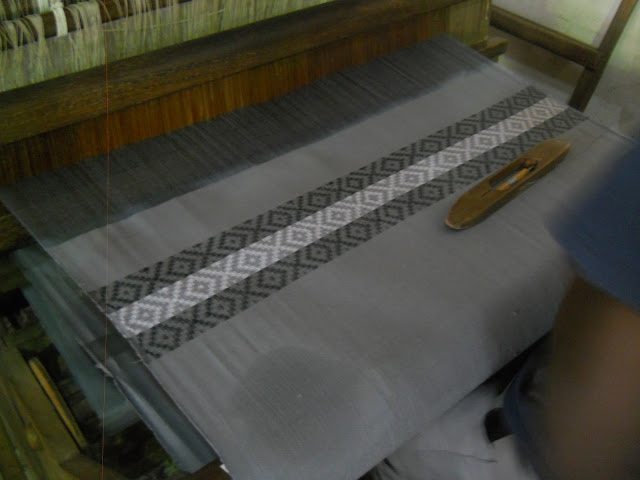Warping
Warping
is the unwinding of a certain length of yarn and a number of them required to
weave a given width of cloth and possibly of a certain weight. During warping, where the intended material is a strip, the threads/yarns must be arranged in a way and manner it should appear in the fabric.
Raddling
Raddling is the evenly distribution of warp yarns on the loom for proper balance using the raddle mounted on the loom. Before beaming raddling is done to ensure that the warp is distributed evenly to ensure proper spread up on the loom for balance and equal tension during weaving and it is done by tying the warp to the tension box.
Raddling is the evenly distribution of warp yarns on the loom for proper balance using the raddle mounted on the loom. Before beaming raddling is done to ensure that the warp is distributed evenly to ensure proper spread up on the loom for balance and equal tension during weaving and it is done by tying the warp to the tension box.
Beaming
Beaming involves the wounding up of the
milled warp yarns around the weavers beam mounted on the loom. During wounding, tension sticks are placed within the warp intermittently to give
added tension within the mounted warp. During beaming, the warp ends are tied to the tension boxes to give tension to the warp.
Heddling
Heddling
is the threading of the warp yarns through the eyes of the hearlds according to a design and it’s draft pattern. During heddling, each and every thread is made to pass through one hearld's eye
Heddling
order is the way and manner the warp yarns are drawn through the healds eyes
that give the fabric a peculiar characteristics.
Tieing of ends to flyer rod.
Reeding
It
is the threading of warp yarns through the dents of the reed. Reeding is done with the reed hook. The yarns are drawn through the dents according to the nature of fabric one intends to produce. Whether light or heavy. Therefore, the ends could be one, two, three or four in a single dent due to the nature of fabric or pattern one intends to produce. Reeding also accounts for the fabric size in terms of the width.
Tieing of ends to flyer rod.
After reeding, the ends are tied to the flyer rod which is connected to the cloth roller.
When tieing the ends to the rod, care must be taken in order to ensure equal
tension in all of the warp spread.
Tie-Up
This process involves the tying of the treadles or pedals to the lams. This is done according to the pattern to be produced since the heddling order must always correspond with the tie-up of the treadles or pedals to the lams.
Weft
preparation
This
is the winding of yarns packaged in form of cone and hanks onto
bobbins for picking. In weft preparation, the weaver prepares the colour of yarns intended to weave a given cloth to match the warp combination.
Weaving order
Weaving
is the interlacing of warp and weft yarns to form a fabric. Weaving order is the way and manner whereby a weaver depresses various pedals to give variety of pattern or effect in the fabric. Weaving order is always deduced from heddling order.





















